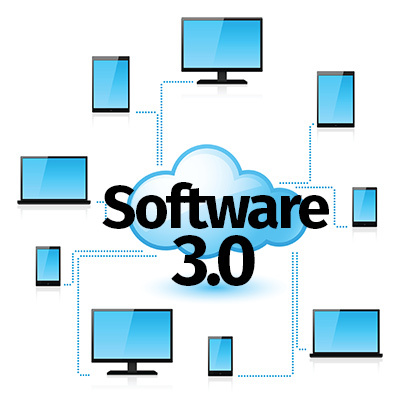Software 3.0: The Quiet Revolution
 For a year, everyone has been asking everyone about what will be “the next big thing”. What will happen after the web, social networks and clouds? In my opinion, the answer lies under our feet, but we do not want to notice it. Just because it’s not quite what we like. This thing is not as simple as everyone expects. There are no more simple things left: Instagram and Groupon - not the most complex products - have already done.
For a year, everyone has been asking everyone about what will be “the next big thing”. What will happen after the web, social networks and clouds? In my opinion, the answer lies under our feet, but we do not want to notice it. Just because it’s not quite what we like. This thing is not as simple as everyone expects. There are no more simple things left: Instagram and Groupon - not the most complex products - have already done.Let's try to take a look back at, say, 35 years. This was the time of the first available personal computers. It was already possible to buy them, but due to the strange interface, understandable only to very assiduous guys, using them was quite difficult. This was the era of software 1.0. The time of pseudographics and the command line, the time when the appearance of a color image on the screen was more impressive than Copperfield's tricks. For obvious reasons, computers, in their then form, could not become truly massive. The software of those times was more scientific and “geeky”, but not personal at all.
Then came the era of graphical user interfaces, the era of Windows, OS / 2 and Mac OS. Computers became more understandable and people began to use them for their daily tasks: creating documents and editing images. This is software 2.0 time. Then came the Internet, social networks and even cloud computing, but software, in most cases, remains the same. If you compare one of the first versions of MS Word and its modern incarnation, you will find that conceptually they practically do not differ. That is, there are more opportunities, but it is still a substitute for a pencil and a sheet of paper.
So we got to our days. Now we have a huge amount of infrastructure that allows us to build very complex solutions in a matter of months. But for some reason, with rare exceptions, the tools remained the same. Cases when the classic word processor has become something big can be counted on the fingers. Take Google Docs. They added the possibility of discussion and collaboration, and I abandoned my beloved MS Word. I think this will be the next big thing - software 3.0. Software that changes the paradigm; software that allows a team of people who are located in different parts of the world to work with the product. Next, I will try to list 10 features that Software 3.0 may have.
1. Making holes, not selling drills
“People don't want to buy a quarter-inch drill. They want a quarter-inch hole. ”
Leo mcginneva
The main characteristic of Software 3.0 will be that it allows you to complete the task, regardless of whether you have the necessary resources (both software and hardware) and competencies for its implementation. If the task is within your reach, then Software 3.0 will provide you with tools, if the task is beyond your capabilities (for example, you do not know how to use photo processing tools), then Software 3.0 will provide you with the help of artists who can cope with your task, as well as tools control and communication with them.
2. This is your data, man.
Data is always owned by the user and stored in his personal / corporate accounts. Basically, this concept replaces the computer’s hard drive from the past. Over time, this hard drive has acquired limitations that are increasingly difficult to put up with. After all, the truth is you want to have access to all files from any of your device. And sometimes not even yours. With the good old hard drive, this will not work. But now there is GDrive, Dropbox, Box, etc. Now these services look like separate products, but over time they will simply become part of the necessary infrastructure. In 2003, we went to an electronics store to buy a hard drive. Now I can hardly imagine where it is in my MacBook.
3. We keep everything so that others can read
It's time to put an end to the struggle for data. Yes, this is the holy grail of a user’s binding to a product when data written by one program cannot be read by another. But this is disgusting. In almost all areas there are already open standards for data, there are no longer any reasonable reasons to do one more for your product.
4. Interaction is the key to efficiency
People communicate. The reason for working together is very simple - the people in the group do the job much better. At the current level of development, any application can provide any means of interaction. I mean, technically, this is not a problem. There is enough infrastructure and technology. Moreover, some technologies have become cross-platform and it’s not such a big problem to call from a phone to a tablet or browser. I will say even more, you can call back and forth at the same time. And add video and text to the communication. Software 3.0 will provide the user with the maximum possible choice of communication tools, in the arsenal of any application will be voice, video chats, means of exchanging messages and files.
5. In-app purchases in full growth
 If we take any area, then most applications and services will have some common functionality. Say GDrive and Dropbox have a login feature. This is a service function that is needed and requires a budget for development and support. This is the logic of the past. Customers will be paid for features that make your service unique. We already see this trend on mobile platforms in the form of in-app purchases: take a look at VSCO, a free application for processing images on smartphones. Well, it seems that in the future, consumers will pay only for unique functions, thus obtaining a unique price-utility ratio of products.
If we take any area, then most applications and services will have some common functionality. Say GDrive and Dropbox have a login feature. This is a service function that is needed and requires a budget for development and support. This is the logic of the past. Customers will be paid for features that make your service unique. We already see this trend on mobile platforms in the form of in-app purchases: take a look at VSCO, a free application for processing images on smartphones. Well, it seems that in the future, consumers will pay only for unique functions, thus obtaining a unique price-utility ratio of products.6. Check the data
Big data just enters the market, we are already seeing the first examples of successful commercialization. Now the analysis of big data is not yet very well developed, but the potential that it stores in itself is really impressive. By analyzing many slices of multidimensional cubes, you can find relationships, the detection of which was previously beyond the reach. Without a doubt, the data that will be created using Software 3.0 will be best suited for analysis.
7. Integrate features
 Most ordinary users do not even suspect the integration density of modern products. In fact, any product is now more a result of integration, rather than writing code. Moreover, I'm not talking about libraries, I'm talking about ready-made services. For example, Google Analytics is integrated into a huge number of products. So far, these integrations remain invisible, but it seems to me that the time is coming when the label “Works with Dropbox” will be as desirable as the once famous “Intel inside”. Over time, integration with third-party products should become one of the main quality metrics in Software 3.0.
Most ordinary users do not even suspect the integration density of modern products. In fact, any product is now more a result of integration, rather than writing code. Moreover, I'm not talking about libraries, I'm talking about ready-made services. For example, Google Analytics is integrated into a huge number of products. So far, these integrations remain invisible, but it seems to me that the time is coming when the label “Works with Dropbox” will be as desirable as the once famous “Intel inside”. Over time, integration with third-party products should become one of the main quality metrics in Software 3.0.8. Zero footprint
Software 3.0 itself will not require any additional modules, plugins or add-ons. Everything that the user needs is already installed on his computer. From software, the user only needs a browser. This approach radically solves the problem of software deployment, all fixes and improvements will always be available in the version that you use. Versions hell, the biggest horror of the developer, is gone forever. I will hardly miss this thing. Installations are also no longer needed, access to the site is the installation. No more, no less.
9. Platform independence
We used to think that the platform is Windows or MacOS. In modern realities, the platform is rather the Web, and the sub-platforms Facebook, Google+, etc. located inside it. Users spend more and more time in applications. There is no longer such a thing as “sitting at a computer”, you always sit somewhere on Facebook, or somewhere else.
Software 3.0 is platform-neutral. This means that you use this software on the platform that is convenient for you. Whether it's a standalone website, a Facebook app, a Chrome OS application, or an Android / iPhone app. Depending on the platform, the software will change the amount of proposed functionality and design to provide the highest quality user experience, provide access to data and the environment.
10. Cloud is a ground
Cloud technology has changed the world forever. There are no more masses of restrictions; clouds allow you to access previously unimaginable resources, data and capabilities. The infrastructure for Software 3.0 is in the cloud. If the task requires intensive calculations over a long time, then all this will happen in the cloud. The user will be delivered only the result.
Conclusion
The world is accelerating, almost all the principles described above can be implemented today. I am sure that every day we will see more and more services that comply with the principles of Software 3.0. These services will help users solve their problems as efficiently as possible. Once upon a time, I read a book by two professors from Sweden , Funky Business . It seems to me that Software 3.0 makes the business approach described in this book possible today.
Eugene Shpika
CEO Pics.io
